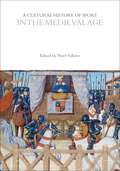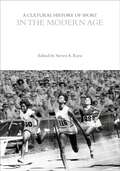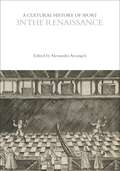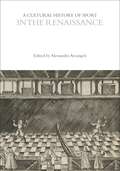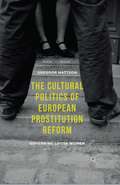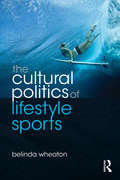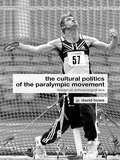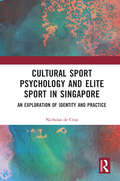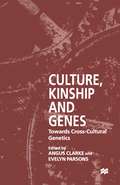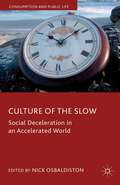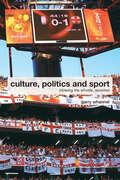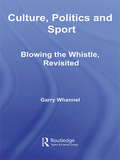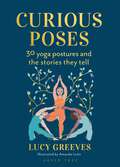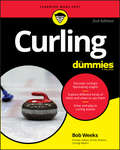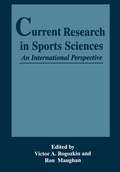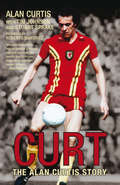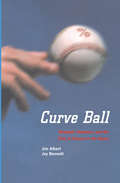- Table View
- List View
A Cultural History of Sport in the Medieval Age (The Cultural Histories Series)
by Noel FallowsA Cultural History of Sport in the Medieval Age covers the period 600 to 1450. Lacking any viable ancient models, sport evolved into two distinct forms, divided by class. Male and female aristocrats hunted and knights engaged in jousting and tournaments, transforming increasingly outdated modes of warfare into brilliant spectacle. Meanwhile, simpler sports provided recreational distraction from the dangerously unsettled conditions of everyday life. Running, jumping, wrestling, and many ball games - soccer, cricket, baseball, golf, and tennis – had their often violent beginnings in this period. The 6 volume set of the Cultural History of Sport presents the first comprehensive history from classical antiquity to today, covering all forms and aspects of sport and its ever-changing social, cultural, political, and economic context and impact. The themes covered in each volume are the purpose of sport; sporting time and sporting space; products, training and technology; rules and order; conflict and accommodation; inclusion, exclusion and segregation; minds, bodies and identities; representation. Noel Fallows is Distinguished Research Professor at the University of Georgia, USA. Volume 2 in the Cultural History of Sport set General Editors: Wray Vamplew, Mark Dyreson, and John McClelland
A Cultural History of Sport in the Medieval Age (The Cultural Histories Series)
A Cultural History of Sport in the Medieval Age covers the period 600 to 1450. Lacking any viable ancient models, sport evolved into two distinct forms, divided by class. Male and female aristocrats hunted and knights engaged in jousting and tournaments, transforming increasingly outdated modes of warfare into brilliant spectacle. Meanwhile, simpler sports provided recreational distraction from the dangerously unsettled conditions of everyday life. Running, jumping, wrestling, and many ball games - soccer, cricket, baseball, golf, and tennis – had their often violent beginnings in this period. The 6 volume set of the Cultural History of Sport presents the first comprehensive history from classical antiquity to today, covering all forms and aspects of sport and its ever-changing social, cultural, political, and economic context and impact. The themes covered in each volume are the purpose of sport; sporting time and sporting space; products, training and technology; rules and order; conflict and accommodation; inclusion, exclusion and segregation; minds, bodies and identities; representation. Noel Fallows is Distinguished Research Professor at the University of Georgia, USA. Volume 2 in the Cultural History of Sport set General Editors: Wray Vamplew, Mark Dyreson, and John McClelland
A Cultural History of Sport in the Modern Age (The Cultural Histories Series)
by Edited by Steven A. RiessA Cultural History of Sport in the Modern Age covers the period 1920 to today. Over this time, world-wide participation in sport has been shaped by economic developments, communication and transportation innovations, declining racism, diplomacy, political ideologies, feminization, democratization, as well as increasing professionalization and commercialization. Sport has now become both a global cultural force and one of the deepest ways in which individual nations express their myths, beliefs, values, traditions and realities. The 6 volume set of the Cultural History of Sport presents the first comprehensive history from classical antiquity to today, covering all forms and aspects of sport and its ever-changing social, cultural, political, and economic context and impact. The themes covered in each volume are the purpose of sport; sporting time and sporting space; products, training and technology; rules and order; conflict and accommodation; inclusion, exclusion and segregation; minds, bodies and identities; representation. Steven A. Riess is Professor Emeritus at Northeastern Illinois University, USA. Volume 6 in the Cultural History of Sport set General Editors: Wray Vamplew, Mark Dyreson, and John McClelland
A Cultural History of Sport in the Modern Age (The Cultural Histories Series)
A Cultural History of Sport in the Modern Age covers the period 1920 to today. Over this time, world-wide participation in sport has been shaped by economic developments, communication and transportation innovations, declining racism, diplomacy, political ideologies, feminization, democratization, as well as increasing professionalization and commercialization. Sport has now become both a global cultural force and one of the deepest ways in which individual nations express their myths, beliefs, values, traditions and realities. The 6 volume set of the Cultural History of Sport presents the first comprehensive history from classical antiquity to today, covering all forms and aspects of sport and its ever-changing social, cultural, political, and economic context and impact. The themes covered in each volume are the purpose of sport; sporting time and sporting space; products, training and technology; rules and order; conflict and accommodation; inclusion, exclusion and segregation; minds, bodies and identities; representation. Steven A. Riess is Professor Emeritus at Northeastern Illinois University, USA. Volume 6 in the Cultural History of Sport set General Editors: Wray Vamplew, Mark Dyreson, and John McClelland
A Cultural History of Sport in the Renaissance (The Cultural Histories Series)
by Alessandro ArcangeliA Cultural History of Sport in the Renaissance covers the period 1450 to 1650. Outwardly, Renaissance sports resembled their medieval forebears, but the incorporation of athletics into the educational curriculum signalled a change. As part of the scientific revolution, sport now became the object of intellectual analysis. Numerous books were written on the medical benefits of sport and on the best way to joust, fence, train horses and ride, play ball games, swim, practice archery, wrestle, or become an acrobat. Sport became the visible sign of the mind's control over the physical body, such control often becoming an end in itself with some sports shaped more by decorum than exercise. The 6 volume set of the Cultural History of Sport presents the first comprehensive history from classical antiquity to today, covering all forms and aspects of sport and its ever-changing social, cultural, political, and economic context and impact. The themes covered in each volume are the purpose of sport; sporting time and sporting space; products, training and technology; rules and order; conflict and accommodation; inclusion, exclusion and segregation; minds, bodies and identities; representation. Alessandro Arcangeli is Associate Professor at the University of Verona, Italy. Volume 3 in the Cultural History of Sport set General Editors: Wray Vamplew, Mark Dyreson, and John McClelland
A Cultural History of Sport in the Renaissance (The Cultural Histories Series)
A Cultural History of Sport in the Renaissance covers the period 1450 to 1650. Outwardly, Renaissance sports resembled their medieval forebears, but the incorporation of athletics into the educational curriculum signalled a change. As part of the scientific revolution, sport now became the object of intellectual analysis. Numerous books were written on the medical benefits of sport and on the best way to joust, fence, train horses and ride, play ball games, swim, practice archery, wrestle, or become an acrobat. Sport became the visible sign of the mind's control over the physical body, such control often becoming an end in itself with some sports shaped more by decorum than exercise. The 6 volume set of the Cultural History of Sport presents the first comprehensive history from classical antiquity to today, covering all forms and aspects of sport and its ever-changing social, cultural, political, and economic context and impact. The themes covered in each volume are the purpose of sport; sporting time and sporting space; products, training and technology; rules and order; conflict and accommodation; inclusion, exclusion and segregation; minds, bodies and identities; representation. Alessandro Arcangeli is Associate Professor at the University of Verona, Italy. Volume 3 in the Cultural History of Sport set General Editors: Wray Vamplew, Mark Dyreson, and John McClelland
The Cultural Politics of European Prostitution Reform: Governing Loose Women
by Greggor MattsonThe Cultural Politics of European Prostitution Reform traces case studies of four European Union countries to reveal the way anxieties over globalization translates into policies to recognize sex workers in some countries, punish prostitutes' clients in others, and protect victims of human trafficking in them all.
The Cultural Politics of Lifestyle Sports (Routledge Critical Studies In Sport Ser.)
by Belinda WheatonThis important new study examines the changing place and meaning of lifestyle sports - parkour, surfing, skateboarding, kite-surfing and others - and asks whether they continue to pose a challenge to the dominant meanings and experience of 'sport' and physical culture. Drawing on a series of in-depth, empirical case-studies, the book offers a re-evaluation of theoretical frameworks with which lifestyle sports have been understood, and focuses on aspects of their cultural politics that have received little attention, particularly the racialization of lifestyle sporting spaces. Centrally, it re-assess the political potential of lifestyle sports, considering if lifestyle sports cultures present alternative identities and spaces that challenge the dominant ideologies of sport, and the broader politics of identity, in the 21st century. It explores a range of key contemporary themes in lifestyle sport, including: identity and the politics of difference commercialization and globalization sportscapes, media discourse and lived reality risk and responsibility governance and regulation the racialization of lifestyle sports spaces lifestyle sports outside of the Global North the use of lifestyle sport to engage non-privileged youth Casting new light on the significance of sport and sporting subcultures within contemporary society, this book is essential reading for students or researcher working in the sociology of sport, leisure studies or cultural studies.
The Cultural Politics of the Paralympic Movement: Through an Anthropological Lens (Routledge Critical Studies in Sport)
by David HoweDo the Paralympic Games empower the disability sport community? Like many other contemporary sporting institutions, the Paralympic Games have made the transition from pastime to spectacle, and the profile of athletes with disabilities has been increased as a result. This book reviews the current status of the Paralympics and challenges the mainstream assumption that the Games are a vehicle for empowerment of the disabled community. Using ethnographic methods unique in this area of study, P. David Howe has undertaken an innovative and critical examination of the social, political and economic processes shaping the Paralympic Movement. In The Cultural Politics of the Paralympic Movement he presents his findings and offers a new insight into the relationship between sport, the body and the culture of disability. In doing so he has produced the most comprehensive and radical text about high performance sport for the disabled yet published. P. David Howe is Lecturer in the Sociology of Sport at Loughborough University. He is also a four-time Paralympian and former Athlete’s Representative to the International Paralympic Committee.
The Cultural Politics of the Paralympic Movement: Through an Anthropological Lens (Routledge Critical Studies in Sport)
by David HoweDo the Paralympic Games empower the disability sport community? Like many other contemporary sporting institutions, the Paralympic Games have made the transition from pastime to spectacle, and the profile of athletes with disabilities has been increased as a result. This book reviews the current status of the Paralympics and challenges the mainstream assumption that the Games are a vehicle for empowerment of the disabled community. Using ethnographic methods unique in this area of study, P. David Howe has undertaken an innovative and critical examination of the social, political and economic processes shaping the Paralympic Movement. In The Cultural Politics of the Paralympic Movement he presents his findings and offers a new insight into the relationship between sport, the body and the culture of disability. In doing so he has produced the most comprehensive and radical text about high performance sport for the disabled yet published. P. David Howe is Lecturer in the Sociology of Sport at Loughborough University. He is also a four-time Paralympian and former Athlete’s Representative to the International Paralympic Committee.
Cultural Sport Psychology and Elite Sport in Singapore: An Exploration of Identity and Practice
by Nicholas de CruzGuided by the principles of cultural sport psychology (CSP), this book explores the psychosocial issues surrounding elite sport and psychological practice in Singapore. CSP recognises the importance of understanding people as individuals, rather than objectifying and interpreting psychological processes independent of the socio-cultural context in which they stem from. For sport psychology to progress, it is imperative to distinguish and appreciate the difference between treating someone the same (i.e., culturally blind approach) and treating them equally (i.e., possess cultural awareness). To address the paucity of cultural-specific research, this book explores the psychosocial issues of elite sport in Singapore using CSP as a theoretical and guiding philosophy. Given Singapore’s recent successes at the Olympic and Paralympic levels, this book is ideally timed to investigate the social and cultural developments of elite sport as they occur in a specific sociocultural context. The authors argue that if elite sport and sport psychology is to progress in Singapore, there is a need to refine its elite ecosystem, regulate the practice of sport psychology, and work towards establishing a professional community centred around a culture of constructive exchange, debate and cooperation. This book presents a blueprint to any researcher, national institute, or practitioner, to systematically explore the culture and context within which they operate and organise action plans to address unique needs that were identified through this process.
Cultural Sport Psychology and Elite Sport in Singapore: An Exploration of Identity and Practice
by Nicholas de CruzGuided by the principles of cultural sport psychology (CSP), this book explores the psychosocial issues surrounding elite sport and psychological practice in Singapore. CSP recognises the importance of understanding people as individuals, rather than objectifying and interpreting psychological processes independent of the socio-cultural context in which they stem from. For sport psychology to progress, it is imperative to distinguish and appreciate the difference between treating someone the same (i.e., culturally blind approach) and treating them equally (i.e., possess cultural awareness). To address the paucity of cultural-specific research, this book explores the psychosocial issues of elite sport in Singapore using CSP as a theoretical and guiding philosophy. Given Singapore’s recent successes at the Olympic and Paralympic levels, this book is ideally timed to investigate the social and cultural developments of elite sport as they occur in a specific sociocultural context. The authors argue that if elite sport and sport psychology is to progress in Singapore, there is a need to refine its elite ecosystem, regulate the practice of sport psychology, and work towards establishing a professional community centred around a culture of constructive exchange, debate and cooperation. This book presents a blueprint to any researcher, national institute, or practitioner, to systematically explore the culture and context within which they operate and organise action plans to address unique needs that were identified through this process.
Culture, Kinship and Genes: Towards Cross-Cultural Genetics
by E. Parsons A. ClarkeThe first comprehensive attempt to explore the issues raised by genetic counselling across cultures. It will be of interest to health professionals and to students and lecturers in the social, behavioural and political sciences and in genetics, medicine and nursing. The meaning and relevance of kinship and ethnicity in the context of genetic disease, cultural issues that have arisen in practice, including the influence of the lay public's beliefs about inheritance and the wider social and political context of genetics and genetic disease are all explored in depth.
Culture of the Slow: Social Deceleration in an Accelerated World (Consumption and Public Life)
by Nick OsbaldistonAcross the world, there has been a growing dissatisfaction with the tempo of modern life. Described simply as the 'slow phenomenon', this volume explores this new brand of living that entails not simply slowing down but an embracing of alternative activities that promote meaning, thoughtfulness, engagement and authenticity.
Culture, Politics and Sport: Blowing the Whistle, Revisited (Routledge Critical Studies in Sport)
by Garry Whannel'Whannel is a foundational figure in the study of sports and the media. …For 20 years his writing has set a high standard …and it remains an inspiration to many' - Toby Miller, Professor of Cultural Studies, New York University, USA Garry Whannel’s text Blowing the Whistle: The Politics of Sport broke new ground when it was first published in 1983. Its polemical discussion brought sports as cultural politics into the academic arena and set the agenda for a new wave of researchers. Since the 1980s sport studies has matured both as an academic discipline and as a focus for mainstream political and public policy debate. In Culture, Politics and Sport: Blowing the Whistle, Revisited, Garry Whannel revisits the themes that led his first edition, assessing their 1980s context from our new millennium perspective, and exploring their continued relevance for contemporary sports academics. This revisited volume will appeal to undergraduate students and researchers in sports and cultural studies. Garry Whannel is Professor of Media Cultures and Director of the Centre for International Media Analysis at the University of Bedfordshire. His previous books include Media Sports Stars: Masculinities and Moralities, Fields in Vision: Television Sport and Cultural Transformation, Understanding Sport (co-authored with John Horne and Alan Tomlinson) and Understanding Television (co-edited with Andrew Goodwin), all published by Routledge.
Culture, Politics and Sport: Blowing the Whistle, Revisited (Routledge Critical Studies in Sport)
by Garry Whannel'Whannel is a foundational figure in the study of sports and the media. …For 20 years his writing has set a high standard …and it remains an inspiration to many' - Toby Miller, Professor of Cultural Studies, New York University, USA Garry Whannel’s text Blowing the Whistle: The Politics of Sport broke new ground when it was first published in 1983. Its polemical discussion brought sports as cultural politics into the academic arena and set the agenda for a new wave of researchers. Since the 1980s sport studies has matured both as an academic discipline and as a focus for mainstream political and public policy debate. In Culture, Politics and Sport: Blowing the Whistle, Revisited, Garry Whannel revisits the themes that led his first edition, assessing their 1980s context from our new millennium perspective, and exploring their continued relevance for contemporary sports academics. This revisited volume will appeal to undergraduate students and researchers in sports and cultural studies. Garry Whannel is Professor of Media Cultures and Director of the Centre for International Media Analysis at the University of Bedfordshire. His previous books include Media Sports Stars: Masculinities and Moralities, Fields in Vision: Television Sport and Cultural Transformation, Understanding Sport (co-authored with John Horne and Alan Tomlinson) and Understanding Television (co-edited with Andrew Goodwin), all published by Routledge.
Curious Poses: 30 Yoga Postures and the Stories They Tell
by Lucy GreevesDeepen your practice and discover the myths, gods, sacred animals and imagery that lie hidden in your favourite yoga posturesMeet the monks and maharajas, gods and gymnasts who shaped yoga as we know it.Have you ever wondered why yoga postures look the way they do, or how they got their names? From Lotus to Warrior, Cobra to Happy Baby, this book takes a fresh look at thestories behind 30 familiar poses. By drawing in on Hindu scripture, mythology and the animals, birds and flowers the original Indian yogis saw around them, Curious Poses explores the symbolism of yoga postures many of us practise every week and offers inspiration to regular practitioners and yoga teachers alike. Let this book take you on a journey into a treasure trove of yoga history, mythology, philosophy and pop culture that enlightens and entertains by turns. Featuring full-colour illustrations, Curious Poses is an ideal mat companion for the curious yoga enthusiast.
Curious Poses: 30 Yoga Postures and the Stories They Tell
by Lucy GreevesDeepen your practice and discover the myths, gods, sacred animals and imagery that lie hidden in your favourite yoga posturesMeet the monks and maharajas, gods and gymnasts who shaped yoga as we know it.Have you ever wondered why yoga postures look the way they do, or how they got their names? From Lotus to Warrior, Cobra to Happy Baby, this book takes a fresh look at thestories behind 30 familiar poses. By drawing in on Hindu scripture, mythology and the animals, birds and flowers the original Indian yogis saw around them, Curious Poses explores the symbolism of yoga postures many of us practise every week and offers inspiration to regular practitioners and yoga teachers alike. Let this book take you on a journey into a treasure trove of yoga history, mythology, philosophy and pop culture that enlightens and entertains by turns. Featuring full-colour illustrations, Curious Poses is an ideal mat companion for the curious yoga enthusiast.
Curling For Dummies
by Bob WeeksCurling For Dummies, 2nd Edition is your one-stop guide to this popular sport. Topics covered include: The history of curling Fundamentals: equipment, the ice and rink, the stone Rules of curling Positioning Different kinds of shots Sweeping Strategy
Curling For Dummies
by Bob WeeksDiscover curling's fascinating origins Explore different kinds of shots and when to use them Enter and play in curling events Your ultimate guide to curling Whether you're a rookie or a seasoned player, fan, or coach, this is the curling book for you. From game fundamentals to complex strategy, here you'll find everything you need to get the most out of the game. Become familiar with the broom, the rock, and the ice, understand the rules and the role of each team member, get into a practice routine, and more. Armed with the many tips and pointers in this fun, friendly book, you'll have no excuse not to head down to your local club and get curling! Inside... Explore curling's history from the 1500s to today Discover the brush, stone, hack, house, and button Form a winning team Improve your delivery, shots, and sweeping Master strategy with and without the last rock Enjoy the unique spirit of the game
Current Perspectives on the Functional Design of the Avian Respiratory System (Zoological Monographs #8)
by John N. MainaBirds have and continue to fascinate scientists and the general public. While the avian respiratory system has unremittingly been investigated for nearly five centuries, important aspects on its biology remain cryptic and controversial. In this book, resolving some of the contentious issues, developmental-, structural- and functional aspects of the avian lung-air sac system are particularized: it endeavors to answer following fundamental questions on the biology of birds: how, when and why did birds become what they are? Flight is a unique form of locomotion. It considerably shaped the form and the essence of birds as animals. An exceptionally efficient respiratory system capacitated birds to procure the exceptionally large quantities of oxygen needed for powered (active) flight. Among the extant air-breathing vertebrates, comprising ~11,000 species, birds are the most species-rich-, numerically abundant- and extensively distributed animal taxon. After realizing volancy, they easily overcame geographical obstacles and extensively dispersed into various ecological niches where they underwent remarkable adaptive radiation. While the external morphology of birds is inconceivably uniform for such a considerably speciose taxon, contingent on among other attributes, lifestyle, habitat and phylogenetic level of development have foremost determined the novelties that are displayed by diverse species of birds.Here, critical synthesizes of the most recent findings with the historical ones, evolution and behavior and development, structure and function of the exceptionally elaborate respiratory system of birds are detailed. The prominence of modern birds as a taxon in the Animal Kingdom is underscored. The book should appeal to researchers who are interested in evolutionary processes and how adaptive specializations correlate with biological physiognomies and exigencies, comparative biologists who focus on how various animals have solved respiratory pressures, people who study respiration in birds and other animals and ornithologists who love and enjoy birds for what they are – profoundly interesting animals.
Current Research in Sports Sciences
by R. Maughan V. A. RogozkinThere are two main reasons for pursuing research in the Sports Sciences. Firstly, by studying responses to exercise, we learn about the normal function of the tissues and or gans whose function allows exercise to be performed. The genetic endowment of elite ath letes is a major factor in their success, and they represent one end of the continuum of human performance capability: the study of elite athletes also demonstrates the limits of human adaptation because nowhere else is the body subjected to such levels of intensive exercise on a regular basis. The second reason for studying Sports Science is the intrinsic interest and value of the subject itself. Elite performers set levels to which others can as pire, but even among spectators, sport is an important part oflife and society. of top sport and elite performers, there is also another reason Apart from the study for medical and scientific interest in sport. There is no longer any doubt that lack ofphysi cal activity is a major risk factor for many of the diseases that affect people in all coun tries: such diseases include coronary heart disease, obesity, hypertension, and diabetes. An increased level of recreational physical activity is now an accepted part of the prescription for treatment and prevention of many illnesses, including those with psychological as well as physical causes. An understanding of the normal response to exercise, as well as of the role of exercise in disease prevention, is therefore vital.
Current Trends in Biomedical Engineering
by Christiane Bertachini Lombello Patricia Aparecida da AnaThis book brings together the latest updates from various subareas of biomedical engineering, providing readers with a broad overview of the current state of the art and the technological trends to be refined in the coming years with the goal of improving human health. It shows the important advances in each subfield, rehabilitation technology, computational systems applied to health, and medical devices, with practical examples. It includes topics not covered in other books in the area, such as digital health, bioprinting, organs-on-a-chip, the open data paradigm, and electrical impedance tomography. It is a short and easy-to-read book, and provides bibliographic references for the reader to go deeper into their areas of interest. This book is aimed at a very broad group of professionals and students in biomedical engineering and related areas, seeking to contextualize and understand the latest scientific advances in each subfield of biomedical engineering, including neuroengineering, regenerative medicine, additive manufacturing orthosis, postural analysis of Parkinson's patients, modelling and simulation using biomechanical open data, regenerative medicine, advanced drug delivery systems, bioprinting, biophotonic and electrical impedance tomography.
Curt: The Alan Curtis Story
by Alan Curtis Stuart Sprake Tim JohnsonWelsh footballer Alan Curtis is synonymous with Swansea City, having played for the club during three different spells, but he also played for Leeds United, Southampton and Cardiff City, and won thirty-five caps for his country during an action-packed playing career that spanned two decades. Alan experienced the highs of the game at the top level with Swansea during their meteoric rise through all four divisions to reach the top flight, but this success came after he'd experienced the low of the Swans having to apply for re-election to the Football League in 1975.In this eventful autobiography, Alan recounts the topsy-turvy turns his career has taken, including a disappointing spell at Leeds United in 1979-80. He was the club's most expensive signing ever at the time, but a nasty clash with Peter Shilton left him sidelined for nine months. Determined to prove his critics wrong and overcome his injury, he played some of the best football of his career upon returning to Swansea, before moving to Southampton in 1983 to help the club challenge the Merseyside dominance of the time.Since his playing career wound down in 1987, Alan has remained in the game as a coach with both Swansea City and Wales, giving back to the game the wisdom and experience he garnered during his years as a player. In Curt, Alan reflects upon his colourful career, highlights just how much the beautiful game has changed since his playing days and explains why he's living proof that nice guys don't always finish second.
Curve Ball: Baseball, Statistics, and the Role of Chance in the Game
by Jim Albert Jay BennettA look at baseball data from a statistical modeling perspective! There is a fascination among baseball fans and the media to collect data on every imaginable event during a baseball game and this book addresses a number of questions that are of interest to many baseball fans. These include how to rate players, predict the outcome of a game or the attainment of an achievement, making sense of situational data, and deciding the most valuable players in the World Series. Aimed at a general audience, the text does not assume any prior background in probability or statistics, although a knowledge of high school abgebra will be helpful.
